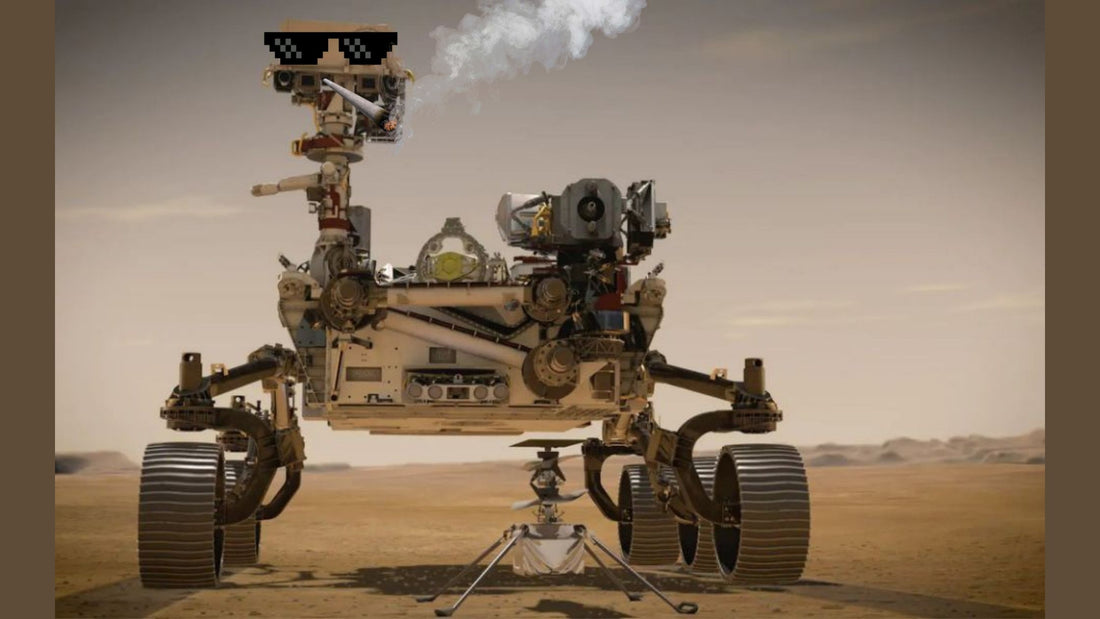
Mysterious Long Cloud On Mars Isn't What We Thought It Was
Share
A long "white cloud" - not New Zealand - hovers over the landscape of Mars.
And it's not an actual cloud.
Or Perseverance smoking the Great Barrier Reefer in a Michael Dooblé. Thanks for the stitch up on the cover image Clintern...
It's a long, bright water ice cloud stretching out over the Martian surface, not in the atmosphere. It extends about 1,800 kilometers from the Arsia Mons volcano all the way to the volcano Olympus Mons, the tallest mountain in the solar system.
What's stranger still is the cloud recurs every year around Mars' southern solstice, with the cloud forming and fading daily for 80 or more days at a time on the Red Planet.
While the cloud isn't new, it's hard to image as a whole because of Mars' dynamic atmosphere and the difficulties of observing the surface from orbit.
Below is the best view of the cloud yet thanks to a special tool: the Visual Monitoring Camera (VMC), or its nickname the 'Mars Webcam'.

A Mars Express image of Arsia Mons on Mars and its strange long cloud, taken on July 19, 2020. (Image credit: ESA/GCP/UPV/EHU Bilbao)
In a new study, astronomers using this data have discovered new details about the long cloud, including how big it can really get and the complex variables at play in the climate system surrounding it.
The VMC was originally installed to spot the Beagle 2 lander, a British Mars lander that was declared lost and is speculated to have crashed.
"However, recently, the VMC was reclassified as a camera for science," said Jorge Hernández Bernal, an astronomer and lead author of the study. "Repurposing the VMC has successfully enabled us to understand this transient cloud in a way that wouldn’t have been possible otherwise," followed Dmitrij Titov, ESA's Mars Express project scientist. The tool allows scientists to "track clouds, monitor dust storms, probe cloud and dust structures in the Martian atmosphere, explore changes in the planet’s polar ice caps, and more," he added.
Astronomers used data from the VMC, NASA's Mars Atmosphere and Volatile Evolution (MAVEN) Mars Reconnaissance Orbiter (MRO), the Viking 2 missions and the Indian Space Research Organization's Mars Orbiter Mission (MOM).
"We were especially excited when we dug into Viking 2’s observations from the 1970s. We found that this huge, fascinating cloud had already been partially imaged that long ago — and now we’re exploring it in detail." Bernal said.

Many missions have helped scientists to study this strange cloud on Mars. (Image credit: ESA)
The researchers found that, at its largest, the cloud measures out to be about 1,800 kilometers long and 150 km across. The cloud forms when wind is pushed upward by surface features like Arsia Mons and is the largest cloud of this type ever seen on the planet.
The cloud is also super responsive to environmental factors, often forming before sunrise then expanding rapidly for about two and a half hours. Its can growth can happen at speeds in excess of 600 kph before it stops and detaches from its point of origin and is stretched even more before evaporating in the late morning. While these clouds, called orographic clouds, do occur on Earth, they're never as big as this Martian one, nor as dynamic, making it especially mysterious.
Now that the researchers have better handle on the life cycle and patterns of this phenomena, it will enable them to more easily target and observe the cloud.
"Many Mars orbiters cannot begin observing this part of the surface until the afternoon due to the properties of their orbits, so this really is the first detailed exploration of this interesting feature — and it’s made possible by not only Mars Express’ diverse suite of instruments, but also its orbit," says study co-author and science lead for the VMC, Agustin Sánchez-Lavega.
We apologise if Clintern upset anyone over the cover image which we cannot be bothered changing.
But if you liked it for some reason, share with a friend to spread ARSE!
#Space_Aus
PS: Ahoy its me Clintern.
we just got in a bunch of ultra snuggly hoodies to beat the brisk.
If you're keen on imitating a warm wallaby, grab one here before they bounce!
Laters!!




